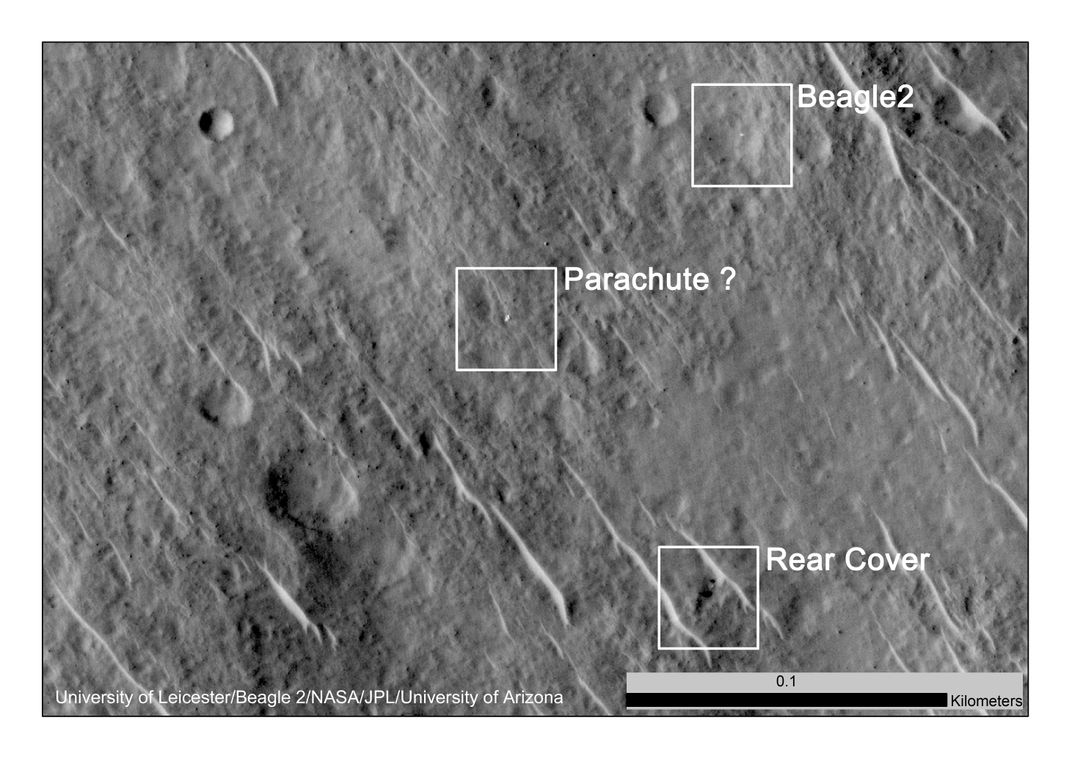Found: One Missing Mars Probe, Still Intact
High-res images of Mars’ surface identify a long-missing probe and suggests that bad luck—rather than human error—caused the loss
/https://tf-cmsv2-smithsonianmag-media.s3.amazonaws.com/filer/26/21/26215f7b-d86b-4cd4-805a-c300f6848901/mars_express_42-46207443.jpg)
In December 2003, after a trip of 63 million miles, Beagle2 was released from the European Space Agency’s Mars Express orbiter and began its decent onto the alien planet. Scientists expected the probe to land on Christmas, but a radio signal was never came through. The machine was never seen or heard from again. Until now.
BBC News reports that researchers studying high-resolution images taken from NASA’s Mars Reconnaissance Orbiter have found the long-lost robot within kilometers of its targeted landing zone. Even more surprisingly, it appears intact. The finding is now helping scientists better understand just what went wrong over a decade ago.

At the time, it seemed possible that a rough landing destroyed Beagle2, a robot built to investigate the surface and atmosphere of Mars. But the fact that the probe is still in one piece indicates that this wasn’t the case. Instead, the images show that “petals” containing solar panels didn’t properly deploy, effectively trapping the radio frequency antenna stowed beneath them.
It’s a bittersweet revelation, as now the Beagle team can see just how close they came to a successful mission. Mark Sims, Beagle2’s mission manager, explained to BBC that the loss of the seven-foot-long probe likely had more to do with a simple lack of good fortune:
"The failure cause is pure speculation, but it could have been, and probably was, down to sheer bad luck - a heavy bounce perhaps distorting the structure as clearances on solar panel deployment weren't big; or a punctured and slowly leaking airbag not separating sufficiently from the lander, causing a hang-up in deployment," he told BBC News.
Beagle2 was the first fully European mission to another planet and was also one of the cheapest interplanetary missions ever launched, with a total cost of £50 million (around $75 million). Its failure caused reforms to future space missions, and now probes like the ExoMars rover, scheduled to land in 2019, are expected to make contact not just when they reach Mars’ surface, but along their descent as well.
Beagle2 isn’t the only probe to be lost on the Red Planet or in its atmosphere. Before the 2003 incident, only three of 11 previously launched probes survived to make contact with Earth.
/https://tf-cmsv2-smithsonianmag-media.s3.amazonaws.com/accounts/headshot/lauraclark.jpeg)
/https://tf-cmsv2-smithsonianmag-media.s3.amazonaws.com/accounts/headshot/lauraclark.jpeg)